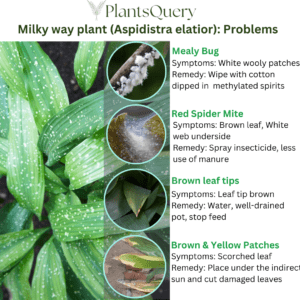Milky way plant
Aspidistra elatior Milky way plants are well known for their tolerant character. This plant belongs to the Liliaceae family. The foliage of this plant is dark green with white small dots that look like the galaxy Milky Way which is why named after the galaxy. And can survive in low, light conditions that’s why they are also known as bathroom plants. The glossy coarse structure of the leaf adds to an excellent background for low flowering annuals or makes effective mass plantings when allowed to spread by underground stems into the groundcover. It also makes a nice face plant in front of a shrub border (1).
The plant is native to Japan and Taiwan and is one of the hardy garden plants and can also be grown as a garden plant. The flexible adaptability of this plant helps in growing both indoors and outdoors, under cold temperatures and also under normal temperatures in low water and light availability, and is almost insect resistant.
Aspidistra elatior Milky Way plant care

Water
This plant requires moderate watering. Water only when the top two to three inches of the soil dried up. During winter seasons water less.
Light and position
The best thing about this plant is that the Aspidistra elatior (Milky Way) plant grows well in low light or moderate light conditions. That is why this plant is also known as a barroom plant. The best position where these plants can be kept is near the window where no direct sunlight comes or not much sun is there.
Temperature
This plant Aspidistra elatior (milky way) can survive a wide range of temperatures from 13 to 24 degrees Celsius. Thus this plant can be kept anywhere from indoor to outdoors.
Soil
The soil for this plant should be well drained. Mostly soil-based mixture is used for potting a. Aspidistra elatior (milky way) plant. No regular need for repotting is required.
Maintainance
The best thing about Aspidistra elatior (milky way) plant is that it does not need much maintenance or seasonal care. Little watering and little feeding is more than enough. water when 2-3 inches of the soil dried off. Feeding once a year will be enough for the growth of this plant too much feeding may result in the splitting of the leaves.
Propagation
The plant Aspidistra elatior (milky way) can be propagated via rhizomes. the new plants can be grown by splitting off the clumps of the stem during the spring season when the pot is overcrowded. Make sure that do not add manure or fertilizers to the new plant until it turns a minimum of one year of age.
Aspidistra elatior Milky Way: Common problems

Yellow leaf
The plant is I think the easiest to take care plant. It needs less light and less water. So make sure that do not overwater the plant. Overwatering results in the yellowing of the leaves because it causes root rot and if roots or rhizomes start rotting then eventually the leaves of the plant get affected. Hence the solution is very simple
- Make sure the pit is draining well
- Just do not water until the top 2-3 inches of the soil dries.
Brown tips
Brown tip or tip necrosis is the classic sign of drying and over minerals or hard water. Water the plant once in week at least to reduce the brown tip issues and for hard water try to rinse the soil of the pot by watering and checking the porosity of the soil. The pot should have a good drainage system so that no hard minerals can accumulate in the soil. Stop feeding the plant as this plant is very hardy overfeeding can also result in tip necrosis or browning.
Dry yellow or browning of the leaves
the brown patches indicate the leaves have been scratched is may be too close to the heat or getting excessive direct sunlight. The only remedy is to cut away the brown patch leaf and place the plant near a window or in indirect sunlight.
Mealy bug
This infects the plant rarely. Mealy bug-infected leaves are wooly in appearance and the patches spread from one leaf to another. The best way to remove the bugs is by wiping them with methylated spirits or spray with insecticides.
Glasshouse red spider mites
The early stage of spider mite attacks how as a fine pale mottling of the upper elaf surface. Tiny yellow-green mites are found on the underside of the leaves. After that, the leave turns brown and produce a white web underside. The best way to remove these is to spray with insecticides.
